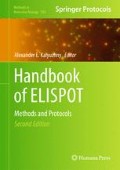Abstract
Over the past decade, ELISPOT has become well-established as a mainstream technology for the study of immune responses in vivo mainly due to its unique ability to detect rare antigen-specific lymphocytes ex vivo. The primary readout for ELISPOT assays has traditionally been the measurement of the frequency of analyte-secreting cells within a test population. While it has been generally appreciated that ELISPOT is a high-information-content assay system in which spot morphologies provide additional valuable information on the amount of analyte secreted by individual cells as well as the kinetics of the secretory process, the precise relationships involved have not been fully characterized and the specific relevant information conveyed by spot morphologies has remained largely unexplored. In an attempt to bridge this gap, we formulated an in silico kinetic model for spot formation and derived a solution for the model in both a general and a numerical form. Both solutions suggested a logarithmic relationship between spot size and cell productivity. This chapter involves an in-depth analysis of the relationship between observed spot morphologies and cells’ secretory functions (as well as an examination of additional assay parameters), and predictions based on the mathematical model are verified under experimental assay conditions where possible.
Access this chapter
Tax calculation will be finalised at checkout
Purchases are for personal use only
References
Hesse M. D., Karulin A. Y., Boehm B. O., Lehmann P. V., and Tary-Lehmann M. (2001) A T cell clone’s avidity is a function of its activation state. J Immunol 167, 1353–1361.
Helms T., Boehm B. O., Asaad R. J., Trezza R. P., Lehmann P. V., and Tary-Lehmann M. (2000) Direct visualization of cytokine-producing recall antigen-specific CD4 memory T cells in healthy individuals and HIV patients. J Immunol 164, 3723–3732.
Targoni O. S., and Lehmann P. V. (1998) Endogenous myelin basic protein inactivates the high avidity T cell repertoire. J Exp Med 187, 2055–2063.
Karulin A. Y., Hesse M. D., Tary-Lehmann M., and Lehmann P. V. (2000) Single-cytokine-producing CD4 memory cells predominate in type 1 and type 2 immunity. J Immunol 164, 1862–1872.
Hofstetter H. H., Targoni O. S., Karulin A.Y., Forsthuber T. G., Tary-Lehmann M., and Lehmann P. V. (2005) Does the frequency and avidity spectrum of the neuroantigen-specific T cells in the blood mirror the autoimmune process in the central nervous system of mice undergoing experimental allergic encephalomyelitis? J Immunol 174, 4598–4605.
Schwander S. K., Torres M., Carranza C. C., Escobedo D., Tary-Lehmann M., Anderson P. et al. (2000) Pulmonary mononuclear cell responses to antigens of Mycobacterium tuberculosis in healthy household contacts of patients with active tuberculosis and healthy controls from the community. J Immunol 165, 1479–1485.
Quast S., Zhang W., Shive C., Kovalovski D., Ott P. A., Herzog B. A., et al. (2005) IL-2 absorption affects IFN-gamma and IL-5, but not IL-4 producing memory T cells in double color cytokine ELISPOT assays. Cell Immunol 237, 28–36.
Guerkov R. E., Targoni O. S., Kreher C. R., Boehm B. O., Herrera M. T., Tary-Lehmann M., et al. (2003) Detection of low-frequency antigen-specific IL-10-producing CD4(+) T cells via ELISPOT in PBMC: cognate vs. nonspecific production of the cytokine. J Immunol Methods 279, 111–121.
Kleen T. O., Asaad R., Landry S. J., Boehm B. O., and Tary-Lehmann M. (2004) Tc1 effector diversity shows dissociated expression of granzyme B and interferon-gamma in HIV infection. AIDS 18, 383–392.
Forsthuber T., Yip H. C., and Lehmann P. V. (1996) Induction of TH1 and TH2 immunity in neonatal mice. Science 271, 1728–1730.
Author information
Authors and Affiliations
Corresponding author
Editor information
Editors and Affiliations
Rights and permissions
Copyright information
© 2012 Springer Science+Business Media, LLC
About this protocol
Cite this protocol
Karulin, A.Y., Lehmann, P.V. (2012). How ELISPOT Morphology Reflects on the Productivity and Kinetics of Cells’ Secretory Activity. In: Kalyuzhny, A. (eds) Handbook of ELISPOT. Methods in Molecular Biology, vol 792. Humana Press, Totowa, NJ. https://doi.org/10.1007/978-1-61779-325-7_11
Download citation
DOI: https://doi.org/10.1007/978-1-61779-325-7_11
Published:
Publisher Name: Humana Press, Totowa, NJ
Print ISBN: 978-1-61779-324-0
Online ISBN: 978-1-61779-325-7
eBook Packages: Springer Protocols

